“People come here and say they drove in Australia and the scenery didn’t change all day. In New Zealand it changes around every damn bend!”
This is Noel, who runs the Wine, Art & Wilderness tour company in Nelson, in the far north of NZ’s South Island. When I meet him I’ve just spent a week with my boyfriend Gavin driving the Top of the South touring route, from quake-hit Christchurch and whale-watching hub Kaikoura, through alpine terrain and the country’s biggest wine region, to end in this city famed for art, food and sunshine. We’ve jet boated through rapids, bathed in thermal pools, biked between vineyards and kayaked in the Marlborough Sounds.
The best bit? Just being in the car each day watching these splendidly shaky isles seemingly form and re-form around us.
Day one: Christchurch
We land in the South Island’s largest city after a three-hour flight from Sydney and go straight to a quintessential Christchurch experience, punting on the Avon. Our guide, spiffing in a tweed jacket, tie and boater, tucks us up with a hot-water bottle and takes us upriver alongside the botanic gardens. As we glide past snowdrops and daffodils, he gives us the lowdown on this city founded on marshes and its post-earthquake reconstruction.
Next we board a heritage tram to see the city centre, trundling past the ruins of the neo-gothic Anglican cathedral (now to be restored), a temporary mall built from shipping containers, and roads lined with cherry blossoms and orange bollards. The scale of the work going on here is staggering.
As the night draws in we check into the Classic Villa, a hotel in a Victorian townhouse with the warm welcome of a B&B. For dinner we visit a shipping container in a bottle-shop car park, where we’re handed a boxed foil tray. It’s the only dish at Pedro’s House of Lamb: a slow-roasted shoulder of NZ lamb atop a pile of potatoes. Gavin is thrilled. Man food!
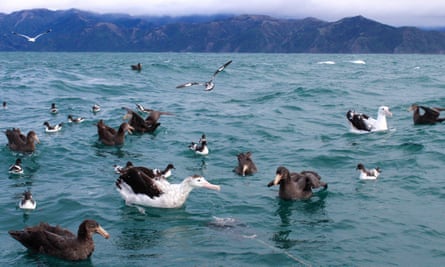
Day two: Waipara and Kaikoura
The day dawns drizzly. We drive north, stopping mid-morning at Black Estate, a striking black box of a cellar door overlooking the green hills of the Waipara wine region. These hills are the first high ground we’ve seen on the trip. (“It was just sheep, now it’s hills and sheep,” Gavin says.) As we sample Black’s biodynamic wine, we wish it was lunchtime already: the menu looks to be a clever mix of hip and hearty.
Back in the car, radio bulletins alert us that State Highway One – the coast-hugging road to Kaikoura being rebuilt after it was hammered by an earthquake, landslips and the tail-end of Cyclone Debbie is closed further ahead, so we strike for the inland route.
Two hours later we pull up in the seaside town. We’re booked for a scenic flight with Wings Over Whales but it’s windy – the ocean is “like soup”, we’re told. It’s a shame: a sea canyon that runs up against the coast here creates a rich feeding ground for a permanent population of sperm whales. These deep-diving predators hunt giant squid and sharks. Migrating humpback, blue, minke and southern right whales can also be seen.
We’re also in the market for a fishy feast, so pull in at the Kaikoura Seafood BBQ – a beachfront caravan – and smash meltingly tender scallops and whitebait, crayfish and pāua (abalone) patties, then park up the road at Point Kean. This is the starting point for the Kaikoura peninsula walkway around the headland, and home to NZ fur seals – a handful of whom are dozing photogenically on the walkway itself.
We stay overlooking the water at the White Morph, and find superior pub grub at the bustling Pier Hotel. I have salad with house-smoked salmon; Gavin goes the “hog roll” – roasted pork belly with chips and veg. It’s hog heaven.

Day three: Hanmer Springs
There are patches of blue in the sky, and glimpses of the snowy mountains overlooking the town, but another disappointment is in store: conditions aren’t right for us to snorkel with dusky dolphins. But Encounter Kaikoura’s other daily tour is going ahead. Would we like to see albatross?
On a small boat in a bracing 2.5-metre swell, we chat to another guest who cares little for dolphins, even as they breach around us. She’s a New Yorker who has just spent two weeks in Australia seeing 246 bird species, but she reckons this morning will be her holiday’s highlight. It’s “super exciting”, she says again and again.
Fifteen minutes from shore our skipper, Victor, puts out a bag of bait. The birds come flocking. Along with gulls, terns and squabbling giant petrels we attract white-capped, Salvin’s and wandering albatross. They bob about close to the vessel and occasionally stretch to show off their world-beating wingspan. To take off they “run” along the water, leaving footprints in the choppy sea.
Back on land the coastal highway is open to the south, so we head back to see the section we missed yesterday. There’s an unusual roadwork sign: “Abseilers working: Look up.”
We look up again and again over the next two hours as we track inland, past snow-capped peaks and across braided rivers. We pull up at Hanmer Springs Attractions, which offers bungee jumping and river rafting. We’re here to try claybird shooting and, within minutes, are standing at the riverbank blasting a shotgun. I bag two, Gavin five – though we’re surprised to get any.
Next we check into the Heritage Hanmer Springs, a grand resort with gorgeous grounds just over the road from this town’s main attraction, the thermal pools. It’s chilly out – 5C and falling – when at dusk we head over for a dip, first in the hydrotherapy bath. At 34C it just isn’t warm enough for me. The 42C sulphur pool is better: like getting into a bath that’s as hot as you can bear but then it doesn’t cool down. Bliss!
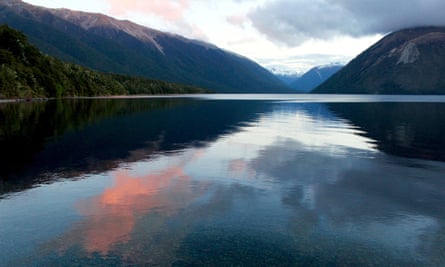
Day four: Buller Gorge and St Arnaud
It’s time to get our hearts racing. We drive two hours’ north-west to Buller Gorge, where we step across a suspension bridge (scary), take a short bushwalk past earthquake faultlines, then zip back across the river on a 160-metre comet line (still scary but it’s over much quicker).
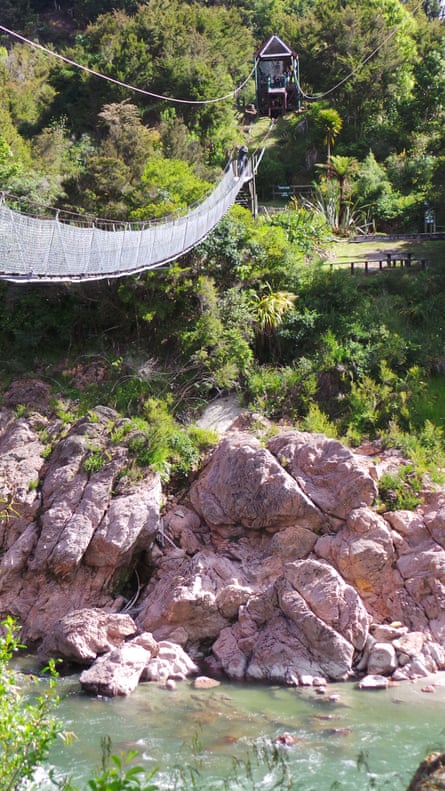
Then it’s down to the river itself for a 40-minute ride down the rapids with Buller Canyon Jet. With cries of “Yeah mama!”, our host, Mark, takes us hammering through rapids, blasting through 360-degree spins and narrowly missing the gorge’s pink granite walls.
But every few minutes he takes the pedal off the metal so we can listen to birdsong and appreciate this wilderness. “Look at that beautiful beech forest, guys,” he says at one point. “You expect a blinky dinosaur to pop its head out of that with a mouthful of ferns.”
Once out of the boat, I don’t fancy the swingbridge again so sign up for a “Supaman” zip ride. The adrenaline surges when I realise this means taking a running leap off a high platform, but I do my best superhero impersonation. The result is ridiculous (I have the video to prove it) but it’s brilliant fun.
The perfect chillout comes at sunset, on the shores of Lake Rotoiti. As bellbirds chime and wind gusts dance across the water, we watch clouds turn peachy pink – and their reflections in the lake glow gold. We wish we had a spare day to take the tramping track all the way around it.
Our accommodation is a stroll away: a pine-panelled studio at Alpine Lodge in St Arnaud. In front of the restaurant’s blazing fire, Gavin swoons over a lamb shank with mash, jus and roasted vegetables; the next morning my eggs with home-smoked, pan-seared salmon are simply smashing.
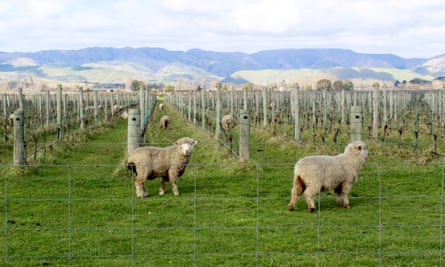
Day five: Blenheim
After a late start, it’s time to lose some altitude on our way to Marlborough. Almost every inland road we’ve been on has followed a river valley; this morning it’s the same except that the lowland rapidly widens and we’re driving through row upon row of sun-kissed grapes. There are still mountains on both sides – they’re just further apart now.
It’s good to be in level country for today’s outing, a cycling tour with Karen of Explore Marlborough. She picks us up from our hotel, the Chateau Marlborough in central Blenheim, and gets us on two wheels. Marlborough is really three wine regions in one. Here in Wairau the sauvignon blanc grapes love stony soil, giving the wine intense flavours of tropical fruit. Across in the Southern Valleys, glacial outwash clay lends subtle mineral notes. And further south still, cold winds in the Awatere make for green, herbaceous drops. Karen is the exact opposite of a wine bore: it’s fascinating to hear about growers calling in frost-fighting helicopters to fly low over budding vines on chilly spring nights.
We stop for lunch at Giesen, where the wines are refined and the menu standout is a lamb shank pie with the bone sticking out of the pastry (Gavin does not resist its Cro-Magnon allure). Then it’s on to Framingham, a riesling specialist where I fall for a luscious off-dry. We finish with fizz at No 1 Family Estate. It’s been barely a 5km loop but, with three wineries under our belts, we fade fast.
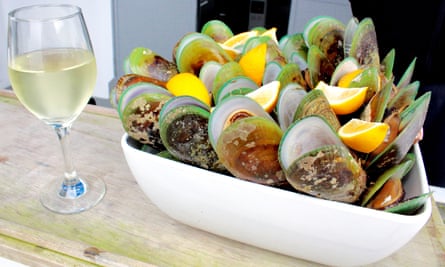
Day six: Marlborough Sounds
The next morning we’re back at the coast, gazing at the glory of Queen Charlotte Sound. It’s the best-known of the Marlborough Sounds – a network of sunken river valleys that make up a fifth of NZ’s total coastline. We might be looking towards the sea but we haven’t left high ground behind – wooded hills rise steeply from the turquoise water. We’re at Ngakuta Bay for a sea kayaking tour with Marlborough Sounds Adventure Company.
I did some kayaking as a teenager, in tiny boats we capsized for fun. Today our large double kayak feels at first like a wobbly tandem bike – and I don’t fancy a dunking. But our guide, Dave, reassures me, and Gavin, unscarred by previous paddling experience, gets the hang of it quickly, so off we go. The fear soon subsides.
Dave points out nesting shags and calls a halt when he spots a seal about 20 metres away. Raising one flipper in a leisurely side-stroke it slips through the water until it’s within paddle distance, then dives away. Suddenly I’m very glad we’re out here.
All too soon we’re in the car again; this time bound for Havelock, at the head of Pelorus Sound. We board a twin-hulled launch skippered by Ryan, a sixth-generation Marlborough man, for a greenshell mussel cruise with Marlborough Tour Company.
As we stop at a farm, Ryan describes the life cycle of mussels – they’re grown from a “white ooze” found on seaweed, a teaspoon of which will yield up to 10,000. The 730 farms here produce about 70% of the world’s supply of greenshell mussels. (Once called greenlip, they were rebranded for the US market – “Because who likes green lips?”) We’d been promised a chance to sample the produce but are staggered to be served up 5kg of just-harvested, freshly steamed, giant-but-tender shellfish with a glass of sauv blanc.
“We like to underpromise and overdeliver,” Ryan says, adding that a French visitor once demolished 7kg of mussels by himself.
We manage to get through about 4.5kg in one of the most memorable seafood experiences of our lives – though it may be months before we can face another bivalve …
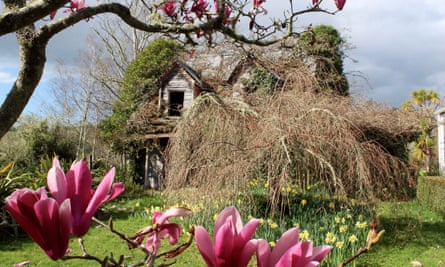
Day seven: Nelson
Our last full day road tripping starts with my favourite drive of the week: from Blenheim to Havelock, past the Hobbit location of Pelorus Bridge, and down a steep range to Nelson. Idyllic farmland, vineyards, sheep, coast and mountains – it’s all the greatest hits.
Once we reach town we turn the driving over to Noel of Wine, Art & Wilderness for a half-day tour of what makes his city special. I’m excited: years ago I visited its Wow museum, which showcases fantastical garments from NZ’s World of WearableArt competition alongside a mind-blowing collection of 140 classic cars.
Noel tells us Nelson is home to 400 artists who are attracted by its light. He takes us past heritage homes and the field where NZ’s first game of rugby was played. We stop at the tiny workshop and showroom of Jens Hansen, a family company that forged the “one ring” for The Lord of the Rings movies, then visit the excellent Parker Gallery before lunch at the Waimea Estates cellar door.
The best bit is a loop west of the city, through Upper Moutere and Motueka. We buy pottery at the beautiful historic home studio of Owen Bartlett and Katie Gold, admire sculptures by Michael MacMillan, then stop for a wine tasting with Lou at Kina Beach Vineyard, a picture-perfect setting that offers guest quarters in a 1930s schoolhouse overlooking the sea and the vines. As we sip chardonnay, Noel sets down bites of local salmon that he has just smoked using a pan and gas burner he had in the car. It’s a lovely touch.
That night at our last dinner of the trip – at the relaxed Monaco Kitchen in our hotel, the Grand Mercure Nelson Monaco – we tuck into scrumptious share plates of fish, pasta and vegetables. As we toast our holiday, we struggle to remember all we’ve seen, and discuss what we’d come back for. But we agree that the landscape doesn’t change around every turn … it’s more like every 15 minutes. We’ve never been anywhere so relentlessly spectacular.

Comments (…)
Sign in or create your Guardian account to join the discussion